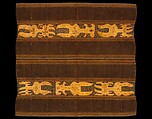Tapis, ceremonial skirt with squid pattern (cumi-cumi) iconography
Not on view
Women’s initiation textiles feature in tribal and courtly culture across the islands of Indonesia, but few can rival those of the peoples of Lampung in Sumatra, whose tapis include ritual cloths that rank among the highest accomplishments of Indonesian textile art. The Lampung region was long renowned for the stature of its ancient Austronesian megaliths, the decorative influence of its Bronze Age and for the cultural impulse of the Srivijaya, a Buddhist-Hindu state that reached its apogee one thousand years ago. In later centuries extreme cosmopolitanism became a significant feature of the region, borne of its location as a maritime crossroads. Ideas and trade goods from China, India, Arabia, and Europe, were exchanged for the region’s prized commodity, Lampung pepper and this extraordinary range of cultural and aesthetic influences created some of the most dynamic and compelling examples of textile art in the region.
This rare textile from the Lampung region of Western Sumatra, Indonesia dates from the 19th century and is in excellent condition. Finely executed, it is an exceptional example of a genre of ceremonial textile from Indonesia known as tapis which were used to wrap women’s hips during rituals. A system of customary law (known as adat) prescribed the use of tapis as ritual wear during rites of passage that saw young women transition into womanhood at puberty and prepare for marriage. Customary law (adat) also guided the adaptation of these ancient cloths into ancestral heirlooms (pusaka) that were consulted when guidance was required for important decisions. The cloth has a foundation of a rich brown color and incorporates contrasting sections of fine embroidery in gold silk thread that feature distinctive iconography in the form of cumi-cumi (squid-like creatures). The techniques of embroidery and ikat are very different. Ikat requires high levels of discipline and organisation in tying resist bundles on the warp yarns before the threads are dyed and woven. Structurally this tends to lead to motifs that are more geometric in nature. Embroidery on the other hand, allows a more fluid expression, one in which the hand of the artist may be more freely sensed.
The composition of this tapis comprises a warp-ikat ground in a rich brown color edged with finely woven rows that create borders for eight separate sections. These feature small rosettes that alternate with small mirrored discs that create a scintillating effect that would have enhanced the stature and ritual efficacy of the piece. The brown warp-ikat badan (or body) of the garment is offset by a pair of contrasting panels, superbly embroidered with a fine golden silk thread. These two broad symmetrical panels run the length of the textile and feature a bold iconography of six squid-like figures known as cumi-cumi which can be interpreted as powerful ancestor spirit forms. These rare cumi-cumi designs are expertly embroidered in a rich golden silk thread, the fluid designs of each dynamic figure embellished and edged in darker shades of contrasting gold and brown which add texture, depth and detail. Each embroidered panel features three large squid-like figures anchored against a dark blue embroidered background. A series of lively curving lines and flecks of mirrored disc, encircled with thread, further animate the design. Vertical woven strips run the length of the textile, one at the center of the textile; two bordering the pair of embroidered panels and one at each running down each edge of the outer textile edges. Further small circular reflective discs, each encircled with precise embroidery, are scattered across the surface of the textile adding to the uniqueness of this example. The work dates from the nineteenth century and is in excellent condition. Small sections that have worn away due to ritual use and the natural age of the piece have been expertly repaired with the ikat designs matched up perfectly.
Due to rights restrictions, this image cannot be enlarged, viewed at full screen, or downloaded.

